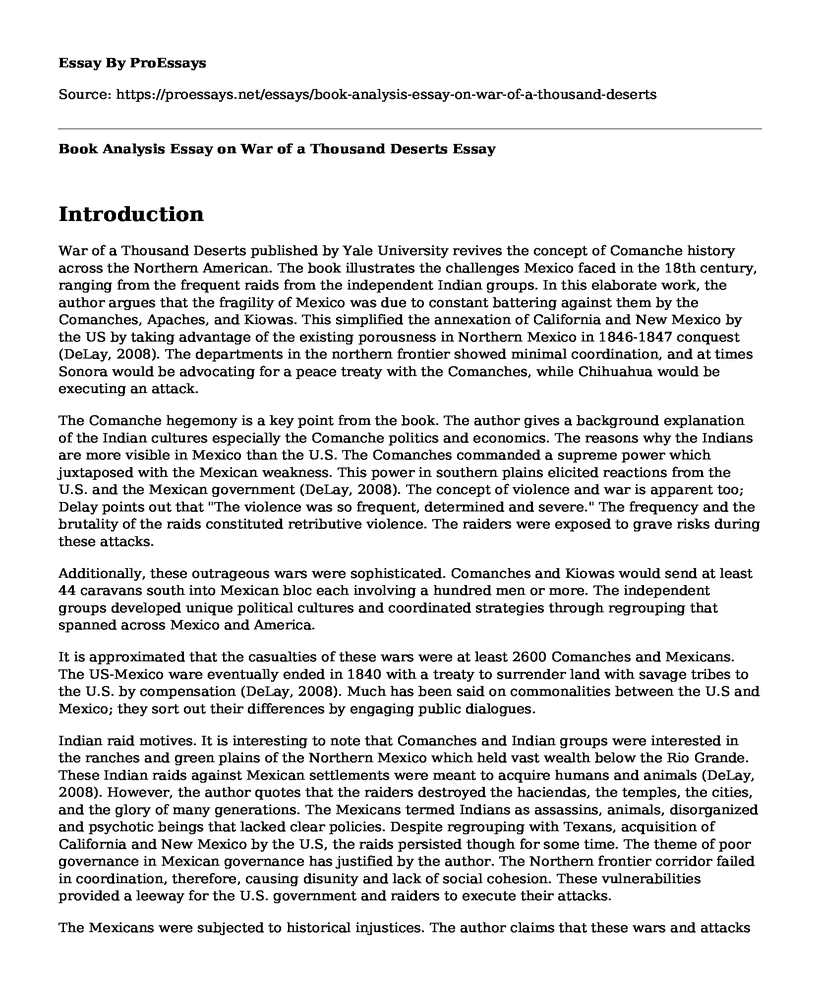Introduction
War of a Thousand Deserts published by Yale University revives the concept of Comanche history across the Northern American. The book illustrates the challenges Mexico faced in the 18th century, ranging from the frequent raids from the independent Indian groups. In this elaborate work, the author argues that the fragility of Mexico was due to constant battering against them by the Comanches, Apaches, and Kiowas. This simplified the annexation of California and New Mexico by the US by taking advantage of the existing porousness in Northern Mexico in 1846-1847 conquest (DeLay, 2008). The departments in the northern frontier showed minimal coordination, and at times Sonora would be advocating for a peace treaty with the Comanches, while Chihuahua would be executing an attack.
The Comanche hegemony is a key point from the book. The author gives a background explanation of the Indian cultures especially the Comanche politics and economics. The reasons why the Indians are more visible in Mexico than the U.S. The Comanches commanded a supreme power which juxtaposed with the Mexican weakness. This power in southern plains elicited reactions from the U.S. and the Mexican government (DeLay, 2008). The concept of violence and war is apparent too; Delay points out that "The violence was so frequent, determined and severe." The frequency and the brutality of the raids constituted retributive violence. The raiders were exposed to grave risks during these attacks.
Additionally, these outrageous wars were sophisticated. Comanches and Kiowas would send at least 44 caravans south into Mexican bloc each involving a hundred men or more. The independent groups developed unique political cultures and coordinated strategies through regrouping that spanned across Mexico and America.
It is approximated that the casualties of these wars were at least 2600 Comanches and Mexicans. The US-Mexico ware eventually ended in 1840 with a treaty to surrender land with savage tribes to the U.S. by compensation (DeLay, 2008). Much has been said on commonalities between the U.S and Mexico; they sort out their differences by engaging public dialogues.
Indian raid motives. It is interesting to note that Comanches and Indian groups were interested in the ranches and green plains of the Northern Mexico which held vast wealth below the Rio Grande. These Indian raids against Mexican settlements were meant to acquire humans and animals (DeLay, 2008). However, the author quotes that the raiders destroyed the haciendas, the temples, the cities, and the glory of many generations. The Mexicans termed Indians as assassins, animals, disorganized and psychotic beings that lacked clear policies. Despite regrouping with Texans, acquisition of California and New Mexico by the U.S, the raids persisted though for some time. The theme of poor governance in Mexican governance has justified by the author. The Northern frontier corridor failed in coordination, therefore, causing disunity and lack of social cohesion. These vulnerabilities provided a leeway for the U.S. government and raiders to execute their attacks.
The Mexicans were subjected to historical injustices. The author claims that these wars and attacks created a lasting psychological shock to the Mexicans due to the brutality of these raids and loss of lives among others. These conflicts contributed to the failure in national cohesion and serial crises which propagated through many decades. The natives who lived in the war zones had their lives transformed by the impact of these wars. Those who owned large acres of land became impoverished, were policed and lived a bounded life. The Indians conjured this transformation by depopulating these regions and opening long-lasting wounds in Mexico's political arena.
Conclusion
In conclusion, the book is about American History, Indian history, and Mexican history. It elaborates the implications and effects of the 18th-century war in this context.
References
DeLay, B. (2008). War of a Thousand Deserts: Indian Raids and the U. S. -Mexican War. Retrieved from https://play.google.com/store/books/details?id=Mot8hkMa0nkC
Cite this page
Book Analysis Essay on War of a Thousand Deserts. (2022, Dec 09). Retrieved from https://proessays.net/essays/book-analysis-essay-on-war-of-a-thousand-deserts
If you are the original author of this essay and no longer wish to have it published on the ProEssays website, please click below to request its removal:
- The Heart of Darkness Literary Analysis
- 'The Yellow Wallpaper' Literary Analysis Essay Sample
- Treaty of Amiens and Treaty of Tilsit Essay Example
- Contextual Analysis: The Roaring 20s
- Essay Sample on 100 Years' War: Dynastic Quarrel between France & England
- Critical Essay Sample on Role of Women in a Brave New World
- A Good Man: O'Connor's Dynamic Reader-Author Assault Essay







